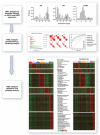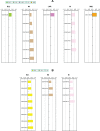TNBCtype: A Subtyping Tool for Triple-Negative Breast Cancer
- PMID: 22872785
- PMCID: PMC3412597
- DOI: 10.4137/CIN.S9983
TNBCtype: A Subtyping Tool for Triple-Negative Breast Cancer
Abstract
Motivation: Triple-negative breast cancer (TNBC) is a heterogeneous breast cancer group, and identification of molecular subtypes is essential for understanding the biological characteristics and clinical behaviors of TNBC as well as for developing personalized treatments. Based on 3,247 gene expression profiles from 21 breast cancer data sets, we discovered six TNBC subtypes from 587 TNBC samples with unique gene expression patterns and ontologies. Cell line models representing each of the TNBC subtypes also displayed different sensitivities to targeted therapeutic agents. Classification of TNBC into subtypes will advance further genomic research and clinical applications.
Result: We developed a web-based subtyping tool TNBCtype for candidate TNBC samples using our gene expression meta data and classification methods. Given a gene expression data matrix, this tool will display for each candidate sample the predicted subtype, the corresponding correlation coefficient, and the permutation P-value. We offer a user-friendly web interface to predict the subtypes for new TNBC samples that may facilitate diagnostics, biomarker selection, drug discovery, and the more tailored treatment of breast cancer.
Keywords: classification; gene expression microarray; meta-analysis; subtypes; triple-negative breast cancer.
Figures




References
-
- Brenton JD, Carey LA, Ahmed AA, Caldas C. Molecular classification and molecular forecasting of breast cancer: Ready for clinical application? J Clin Oncol. 2005 Oct 10;23(29):7350–60. - PubMed
-
- Morris GJ, Naidu S, Topham AK, et al. Differences in breast carcinoma characteristics in newly diagnosed African-American and Caucasian patients—A single-institution compilation compared with the National Cancer Institute’s Surveillance, Epidemiology, and End Results Database. Cancer. 2007 Aug 15;110(4):876–84. - PubMed
-
- Haffty BG, Yang Q, Reiss M, et al. Locoregional relapse and distant metastasis in conservatively managed triple negative early-stage breast cancer. Journal of Clinical Oncology: Official Journal of the American Society of Clinical Oncology. 2006 Dec 20;24(36):5652–7. - PubMed
-
- Dent R, Trudeau M, Pritchard KI, et al. Triple-negative breast cancer: clinical features and patterns of recurrence. Clin Cancer Res. 2007 Aug 1;13(15 Pt 1):4429–34. - PubMed
-
- Foulkes WD, Smith IE, Reis JS. Triple-Negative Breast Cancer. New Engl J Med. 2010 Nov 11;363(20):1938–48. - PubMed
Publication types
Grants and funding
LinkOut - more resources
Full Text Sources
Other Literature Sources

